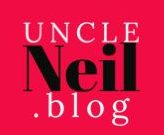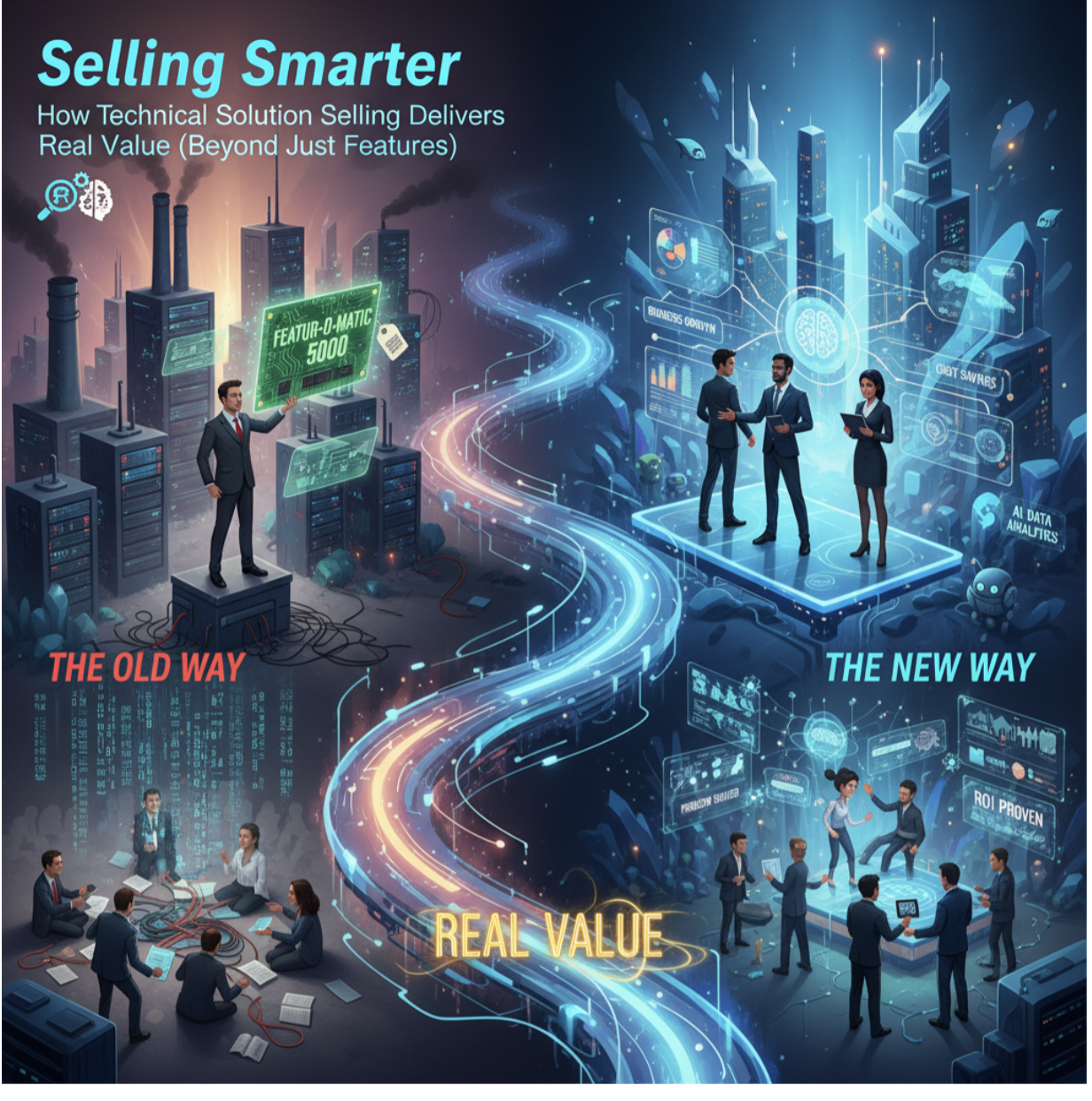Selling Smarter: How Technical Solution Selling Delivers Real Value (Beyond Just
Features)
Introduction: The Old Way vs. The New Way in Tech Sales
Remember the days when buying technology felt like deciphering an alien language,
poring over spec sheets thicker than a Tolkien novel? Megahertz, gigabytes, pixel
counts… a feature parade marching endlessly by. Those days, thankfully, are fading.
We’re entering an era where smart businesses – both buyers and sellers – understand
that technology is only valuable insofar as it solves real problems. This brings us to
Technical Solution Selling. It’s more than just a trendy buzzword; it’s a fundamental shift
in how we approach the complex world of technology transactions. In an ocean teeming
with similar features, how do you cut through the noise and demonstrate genuine value?
How do you articulate not just what a product does, but why it matters to the bottom
line?
The “What”: Demystifying Technical Solution Selling
Let’s be clear: Technical Solution Selling isn’t about pushing boxes filled with blinking
lights. It transcends the mere peddling of features. It’s about understanding the intricate
puzzle of a customer’s needs and crafting a tailored solution from a mix of products and
services that addresses those needs. Think of it as the difference between a pharmacist
who dispenses pills and a doctor who diagnoses and treats the underlying ailment.
This approach is particularly crucial in the realm of complex software, sophisticated
hardware, intricate networks, and the accompanying services that make them function
harmoniously. Sales professionals operating in this space require a robust technical
foundation, capable of navigating complex architectures and understanding the nuances
of integration. But technical acumen alone isn’t enough. They must also be adept at
translating “geek-speak” into clear, concise “business-speak,” bridging the gap between
technical capabilities and strategic business outcomes.
To truly grasp the power of Technical Solution Selling, it’s vital to distinguish between
features, benefits, value, and solutions:
Features: These are the inherent characteristics of a product (e.g., a car gets 50
MPG).
Benefits: These are the direct advantages a feature provides (e.g., saving
money on gas due to the car’s MPG).
Value: This is the ultimate, big-picture outcome that aligns with a customer’s
strategic goals (e.g., the car reduces overall operating costs, freeing up budget
for innovation).
Solution: This is the comprehensive package – the product, the services, the
integration – that delivers that value.
A Blast from the Past: The Evolution of Selling
To truly appreciate where we are, we must glance back at whence we came. The
evolution of selling methodologies reveals a fascinating journey from feature-centric
pitches to value-driven engagements.
In the early days (pre-1970s), sales was largely a “feature parade.” Salespeople rattled
off technical specifications, leaving customers to determine relevance. The onus was
entirely on the buyer to translate those features into practical benefits.
A seismic shift occurred in the 1970s and 1980s, spearheaded by visionaries like Frank
Watts at Wang Laboratories (1975) and Michael Bosworth at Xerox. Watts began
focusing on understanding the specific issues faced by customers, marking a departure
from the traditional product-focused approach. Bosworth, in the 1980s, formalized this
methodology, coining the term “Solution Selling®” and solidifying its principles in his
influential 1994 book. The core tenet? Understand the problem before presenting the
product.
Value Selling emerged in the 1980s, building upon the foundations of Solution Selling by
explicitly emphasizing measurable economic impact and ROI. Tom Reilly’s “Value-
Added Selling Techniques” (1984) played a pivotal role in shaping this approach. Xerox,
again, proved to be a fertile ground for innovation, with many early value-based models
originating within the company.
As buyers became increasingly informed (thanks to the rise of the internet), traditional
Solution Selling faced scrutiny. The focus shifted towards “insight selling,” where sales
representatives challenge customers’ assumptions and provide new perspectives,
becoming trusted advisors rather than mere order-takers.
Current Opinions & The “Getting Real” Approach
Today, customer-centricity reigns supreme. It’s about placing the customer’s needs and
business objectives at the very heart of the sales process.
“Getting Real” with clients means abandoning generic pitches and embracing a more
authentic, collaborative approach:
Deep Dive Discovery: Meticulously research their industry, business model, and
unique challenges, asking probing questions to uncover their true pain points.
Outcome Over Output: Shift the conversation from technical specifications to
how your solution directly addresses their specific problems and contributes to
their long-term strategic goals. Ditch the tech jargon and speak their language.
Trusted Advisor Status: Position yourself as a trusted collaborator, not just a
vendor. Become an indispensable resource, guiding them towards success.
Listen, Don’t Lecture: Let the client dominate the conversation. Your role is to
diagnose, not to prescribe a pre-packaged cure. Understand their perspective
before offering solutions.
Metrics Matter: Discover how they measure success. Utilize their language and
their key performance indicators to demonstrate value in terms that resonate with
them.
Embrace “No”: Not every solution is a perfect fit. A transparent “no” can save
everyone valuable time and resources, fostering trust and long-term
relationships.
The Elephant in the Room: Controversies and Challenges
Despite its merits, Technical Solution Selling isn’t without its challenges and
controversies. We must address the “elephant in the room” to ensure its effective
implementation.
The Feature vs. Value Tug-of-War: While value is paramount, features still hold
relevance, especially for technical buyers (engineers, IT professionals) who
require detailed specifications for compatibility and reliability. However, the
danger lies in “feature dumping” – overwhelming non-technical stakeholders with
irrelevant details, leading to confusion and lost sales. The key is to seamlessly
link every feature to a tangible benefit, and that benefit to quantifiable value.
The “Solution” Jargon Trap: The term “solution” has become ubiquitous,
almost cliché. Customers are increasingly skeptical, viewing it as a marketing
buzzword that masks a self-serving sales agenda.
The Long Haul: Technical solution sales typically involve longer sales cycles,
often extending 30-50% longer than traditional sales processes. This can strain
resources, impact cash flow, and require unwavering patience.
Skills Gap: A significant challenge lies in bridging the skills gap within sales
teams. Many tech-focused salespeople lack strong business acumen (account
planning, ROI analysis, pipeline management), while others struggle to
communicate effectively with both technical experts and non-technical
executives.
Over-Customization Risk: The temptation to tailor every solution to perfection
can lead to scalability issues and increased costs. Striking a balance between
customization and standardization is crucial.
Informed Buyers & “Unpaid Consultants”: Modern buyers conduct extensive
research before engaging with sales representatives. Salespeople risk becoming
“unpaid consultants,” providing valuable information that customers then
leverage to negotiate with competitors.
Internal Friction: Misalignment between sales, marketing, and technical teams
regarding customer needs, timelines, and product features can hinder the entire
sales process.
Looking Ahead: The Future is Intelligent, Personalized, and Even More Value-
Driven
The future of Technical Solution Selling is inextricably linked to advancements in
artificial intelligence, data analytics, and emerging technologies.
AI & Data Analytics: Your New Best Friends: AI-powered tools will automate
routine tasks (lead scoring, data entry, follow-ups), freeing up sales engineers to
focus on complex problem-solving. Hyper-personalization, driven by AI’s ability to
analyze vast datasets, will enable incredibly tailored pitches and demos.
Predictive analytics will empower sales teams to anticipate customer needs and
identify opportunities before customers even realize they exist. AI-powered virtual
assistants and chatbots will streamline the early stages of the sales funnel,
enhancing efficiency and responsiveness.
Evolution of the Sales Role: We’ll see a growing demand for technical talent
directly embedded within sales teams, transforming the traditional sales
representative into a “go-to-market engineer” capable of crafting and
demonstrating bespoke solutions.
Human Element Remains Key: Despite the rise of AI, empathy, creativity, and
relationship-building will remain irreplaceable in high-value interactions. These
uniquely human skills will be critical for building trust and fostering long-term
partnerships.
Value as a Deliverable, Not a Promise: The focus will shift from
merely promising ROI to proving it with data. We’ll see a greater emphasis on
“Return on Value” across the entire customer journey, demonstrating the ongoing
impact of the solution.
Dynamic Positioning: Leveraging real-time data to continuously adapt
positioning strategies based on market shifts and evolving consumer behavior
will be essential for maintaining a competitive edge.
New Tech on the Horizon: Emerging technologies like edge computing,
quantum computing, and extended reality (XR) will create increasingly complex –
and valuable – solutions that demand an advanced, value-driven selling
approach.
Conclusion: Master the Value, Win the Sale
In conclusion, Technical Solution Selling – characterized by “getting real” with clients
and presenting value-driven solutions – isn’t simply a strategy; it’s the sine qua non for
success in today’s complex technology market.
This approach necessitates deep listening, strategic thinking, technical expertise, and
an unwavering commitment to the customer’s success. It demands a shift in mindset, a
move away from pushing products and towards creating meaningful, lasting value.
Your next step is clear: Stop selling features. Start selling solutions.

